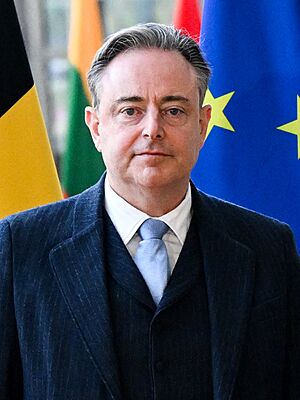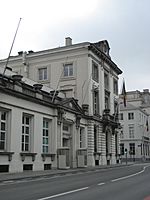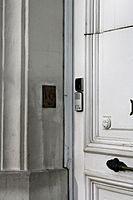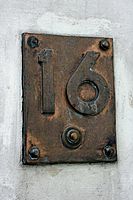Prime Minister of Belgium facts for kids
Quick facts for kids Prime Minister of the Kingdom of Belgium |
|
|---|---|

State ensign
|
|
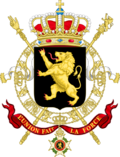
|
|
| Executive branch of the Belgian Federal Government |
|
| Style | Mr Prime Minister (informal) His Excellency (diplomatic) |
| Member of |
|
| Residence | Le Lambermont, Brussels |
| Seat | 16, Rue de la Loi, Brussels |
| Appointer | Monarch of Belgium |
| Term length | No term limit |
| Formation | 26 February 1831 (de facto) 1918 (de jure) |
| First holder | Étienne de Gerlache |
| Salary | €236,900 annually |
| Website | premier.be |
The Prime Minister of Belgium is the leader of Belgium's federal government. This person is often seen as the most powerful figure in Belgian politics. The title is also known as the Premier of Belgium.
The first person to lead the government in Belgium was Henri Van der Noot in 1790. This was during the short time of the United Belgian States. Even though government leaders were appointed after Belgium became independent, the modern role of Prime Minister really started after World War I. Before 1918, the King of the Belgians often led meetings of the Council of Ministers. But when Léon Delacroix was appointed, the role of Premier became much more important. Over time, the King's political power lessened, and the Prime Minister's role grew.
Bart De Wever, who leads the New-Flemish Alliance party, became the new Prime Minister on February 3, 2025. He is the first Flemish Nationalist to hold this position. He took over from Alexander De Croo.
Contents
How the Prime Minister's Role Developed
Early Leaders of Belgium
In 1790, the Sovereign Congress met in Brussels. It had representatives from each of Belgium's eight provinces. Henri Van der Noot was the President of this Congress.
After Belgium gained independence in 1830, governments were named after the minister who formed them. This person was called the formateur. However, this role did not have a special official status. From 1831, the King of the Belgians usually led the Council of Ministers. If the King was not there, the chef de cabinet (head of Cabinet) would lead. This was usually the oldest or most influential minister.
Growing Importance of the Role
This "head of Cabinet" position slowly became more important. The person in this role soon gained the power to suggest how ministerial jobs should be given out.
After World War I, more people could vote. This meant more political parties won seats in parliament. It became impossible for one party to have a full majority. Because of this, different parties had to work together to form coalition governments. This made forming a government much harder. The formateur who managed this process gained more respect and importance. This is how the formateur became a true leader. Since ministers now came from different parties, someone was needed to coordinate them. The Prime Minister became the actual head of government. This is how the office of Prime Minister came to be.
Official Recognition of the Prime Minister
During the first half of the 20th century, the head of Cabinet more often took the King's place. This made the role even more important within the government. The Belgian Constitution says the King must use his powers through ministers. So, the Prime Minister became the country's most important political figure. They became the de facto chief executive. Even with this new importance, the head of Cabinet still led a ministerial department.
The title "Prime Minister" or "Premier" was first used in official papers in 1918. At this time, the position got its own special office. The title was finally added to the Belgian Constitution in 1970. This happened during the first state reform.
What the Prime Minister Does
The Prime Minister has many important jobs. They coordinate government policies. They also make sure the coalition agreement is followed correctly. The Prime Minister leads meetings of the Council of Ministers. They also help solve disagreements between ministers.
The Prime Minister represents the government to the public, both in Belgium and other countries. They keep in touch with the King. They also present the government's plans to the Parliament. The Prime Minister can ask Parliament for a vote of confidence. If the government loses this vote, it might have to resign. If the Prime Minister resigns for personal reasons, the whole government usually resigns too.
The Prime Minister also represents Belgium in international groups. They do this alongside the Minister of Foreign Affairs. Because of changes to the Belgian state, the Prime Minister gained more duties. These include managing relationships between Belgium's different regions and communities. They also lead a special committee of government representatives from all parts of the country.
It is generally expected that the Prime Minister can speak both French and Dutch fluently. However, this is not a strict rule.
How a Prime Minister is Chosen
Forming a New Government
After federal elections, the current Prime Minister offers the government's resignation to the King. The King then asks the resigning government to continue working as a caretaker government. This temporary government stays in place until a new one is formed.
The King then talks to many important politicians. This helps him understand how a new government might be formed. He usually talks to the leaders of the Chamber of Representatives and the Senate. He also consults with the main political parties and other important people.
After these talks, the King appoints an informateur. This person gathers information from different political parties. They learn what each party wants for a new government. After these discussions, the informateur reports back to the King. This helps the King find a suitable formateur. The formateur is responsible for actually putting the new government together. Usually, the formateur of the federal government becomes the new Prime Minister.
Official Appointment
It often takes several months of talks before the formateur is ready to form a government. The King then formally invites them to do so. The Constitution says that the King's actions are only valid if a minister also signs them. So, the outgoing Prime Minister signs the document appointing the new Prime Minister. The new Prime Minister then signs the document for the outgoing Prime Minister's resignation. The King then appoints the other ministers and secretaries of state for the federal government. The Prime Minister signs their appointment documents.
The Prime Minister's Office
The official office of the Prime Minister is at 16 Rue de la Loi in Brussels. This street is also known as Wetstraat in Dutch, meaning "Law Street." Many important Belgian government and European Union buildings are located here. The office building includes the Belgian Federal Cabinet, the Chancellery, and the Council of Ministers. It is like the central hub of Belgian politics.
The building was first built as a "Refuge House" for the Saint Gertrude Abbey of Leuven. It was designed by the architect Louis Joseph Montoyer. During the time of the United Kingdom of the Netherlands (1815–1830), the building was meant to be the Ministry of Foreign Affairs. In 1830, Prince Eugène of Ligne bought it. Since 1944, the building has been owned by the state. It was then set up to be a meeting place for the Prime Minister and the cabinet.
See also
 In Spanish: Primer ministro de Bélgica para niños
In Spanish: Primer ministro de Bélgica para niños
- List of Belgian monarchs
- List of prime ministers of Belgium
- History of Belgium


